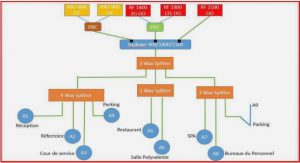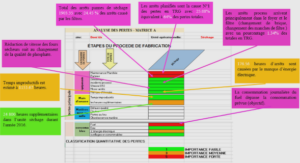Linear modulated test signais
Modern communication systems are continuously developed to reach higher data rate. Nowadays, digital communications are widely used, taking advantages of digital signal filtering and modulation progression, which offers a greater data rate and a judicious exploitation of the frequency band.
To make the data transmission more resistant to the transmission channel disturbances, extra data bits for encoding, commonly called redunda ncy bits, are used. Source encoding purpose is to ensure a data transmission more efficient 1181 by realization of data compression, These characteristics and operations make the amplified and transmitted source of information very redundant ; it is a specification that will be advantageous in realizing the proposed data on-line modeling and predistortion architecture. Linear modulation tech-niques are widely employed, for their high data rate using a relati vely narrow frequency band. In this section, it will be presented briefly the linear modulation techniques tested in the simulations of the present work.
Memory power amplifier data on-line modeling architecture
Neural network theory
The modeling of microwave PAs is one of the key subject in wireless communication systems. This is mainly driven by the need of precise model to be used for behavioral study and linearization of PAs. Through evolution of technology in DSPs , FPGAs, ADC and DAC, the PA is modeled and dynamically characterized on a wide bandwidth with excellent performances. With the improvement of modulation techniques, the dynamic behavioral modeling is inescapable. In this section, it will be validated, by simulation , with the test signal (16-QAM) the results given in several works . A RVTDNNs archi tecture will be realized with XSG software in the MatlabjSimulink environment. The proposed model is based on the sam pied baseband signal, after being filtered by the pulse shaping filter. The model based on data before the pulse shapin g tllter can not weil model t he output-of-band behavioral, because it can not compensate the out-of-band distortions when Iinearizing . This model is able to reproduce at the same time out-of-band (ACPR) and in-band (EVM) distortions. signaIs I pin and Qp.in are modulated to be injected by a 90°-coupler in the PA, at the output, the RF signal is passed through a 90°-coupler and is demodulated to get the distorted Ip.out and Qp.out signaIs.
Memory power amplifier data on-line predistortion architecture
Back-propagation algorithm modification
Neural networks are used in linearizing PAs because of their capability of modeling and fitting nonlinearities. Using that, this cha racteristic can be generalized to memorize severe nonlinearities wit h memory. Linearization with RVTDNNs is reported in the work of Hwangbo et al. by using the indirect learning architecture. It was proved that the trained NN is able to operate with (3G) base-station signais such as WCDMA and CDMA2000! 411. The proposed NN for linearization consists of a simila r archi tecture (RVTDNNs) used for PAs modeling with the back-propagation algorithm in the adaptat ion process.
The proposed NN predistortion architecture is based on sampled base band signais, the Modem operations are achieved before using the signais by the FPGA board. This architecture can be applied for any type or class of PAs. It can be achieved with complex signais like COMA and OFDM without modification of the NN general structure!651. The block is used to compensate the PA linear gain in the backward information flow. The data on-line adaptation is needed only when the PA characteristics change with long-term memory effect caused mainly by phenomena of self heating and aging of t he PA.
Neural network architecture implementation with XSG software
In this section , we present the proposed NN architecture implementation with XSG software which will be implemented on FPGA board in future research work. This architecture is designed for applications with Xilinx FPGA circuits, and this softwa re gives the opportunity to realize applications with very high integration level. It has been adopted as a nonlinear activation function of t he hidden layer neurons the t angent hyperbolic function tanh ( . ) . In digital systems, t here are many kinds of representation for data, values of synaptic weights, biases. Input and output signais are real-valued and they can be presented even in digital or analog forms. When using digital representation, signal values can be presented on floating or fixed-point format and they can be seriai or parallel. Ideally, design with floating point precision is more flexible and easy for manipulation . However, this advantage has a price in term of silicon surface and number of input/output pins. For hardware implementation and because of t he high price of arithmetic with floating point precision , it is necessary to use the fixed point simple precision presentation with two’s complement Fix format which can provide a precision of about 4 x 10- 9 on the parameter variations and data are between -1 and 1. The work frequency of the FPGA board depends on the signal frequency and t he rapidity of the AOC / DAC circuits, Because Matlab uses double precision presentation , the XSG software provides the use of blocks Gateway-in and Gateway-out like communication point between the FPGA and Simulink parts. The general presentation of data with simple fixed point precision consists of two parts : signed or unsigned numbers. Two’s Complement Fixed Point Format can even represents negative and positive numbers .
|
Table des matières
CHAPITRE 1 :INTRODUCTION
1.1 Généralités
1.2 Problématique
1.3 Hypothèses
1.4 Méthodologie retenue
1.5 Contributions apportées
CHAPITRE II :A NEURAL NETWORK APPROACH FOR THE LINEARIZATION OF RADIO-FREQUENCY POWER AMPLIFIERS WITH ADAPTIVE PREDISTORTION
2.1 Abstract
2.2 Introduction
2.3 Linear modulated test signais
2.4 Power amplifier original model
2.4. 1 Memoryless non linear subsystem
2.4.2 Memory linear subsystem
2.4.3 Memory nonlinearity system
2.5 Linearization performance criteria
2.6 Memory power amplifier data on-line modeling architecture
2.6. 1 Neural network theory
2.6.2 Back-propagation algorithm
2.6.3 Simulation results
2.6.4 Discussions and conclusion
2.7 Memory power amplifier data on-line predistortion architecture
2.7.1 Back-propagation algorithm modification
2.7.2 Simulation results using 16-QAM test signal
2.7.3 Test of the architecture with other PA model and modulated signal
2.7.4 Discussions and conclusion
2.8 Neural network architecture implementation with XSG software
2.8.1 Forward propagation module
2.8.2 Backward propagation module
2.8.3 Decision module
2.8.4 Discussions and conclusion
2.9 General conclusion and future works
CHAPITRE III :CONCLUSION GÉNÉRALE
ANNEXE
![]() Télécharger le rapport complet
Télécharger le rapport complet






